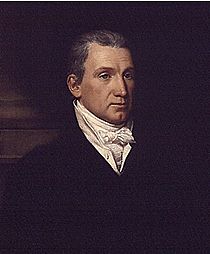Monroe Doctrine facts for kids
The Monroe Doctrine was an important foreign policy announced by the United States in 1823. This happened when James Monroe was President. The main idea was that European countries should not try to create new colonies or take back old ones in North and South America.
President Monroe created this rule because many parts of the Spanish Empire in South America had just become independent. These countries had fought for their freedom, often against France. After Spain won the Peninsular War in Europe, it wanted to get its old colonies back. The Monroe Doctrine sent a clear message: the United States would not allow Spain to take back any land in the Americas. The United Kingdom also agreed with this idea and helped make sure it was followed.
Contents
What Was the Monroe Doctrine?
The Monroe Doctrine was a big statement from the United States to the rest of the world. It basically said:
- European countries should not try to set up new colonies in North or South America.
- European countries should not try to control countries that had already become independent in the Americas.
- The United States would stay out of European wars and their colonies.
- If European countries tried to interfere in the Americas, the U.S. would see it as a threat.
This policy aimed to protect the newly independent countries in the Americas. It also showed that the United States was becoming a stronger nation on the world stage.
Key People Behind the Doctrine
The Monroe Doctrine was named after President James Monroe. However, another very important person helped write it:
- John Quincy Adams was the Secretary of State at the time. He later became a President himself. Adams played a big role in shaping the ideas of the doctrine.
President Monroe also wanted to stop Russia from gaining more power in western North America. The Monroe Doctrine was meant to apply to any country trying to take control in North America.
When Was the Doctrine Announced?
President Monroe first shared the doctrine with the public on December 2, 1823. He did this during his annual State of the Union Address to Congress. This was a major speech where he talked about the country's important plans.
How the Monroe Doctrine Was Used
Over the years, many U.S. Presidents have used the Monroe Doctrine to guide their foreign policy. It has been used in different ways, sometimes to protect American interests.
The Roosevelt Corollary (1904)
- In 1904, President Theodore Roosevelt added something new to the Monroe Doctrine. He called it the "Roosevelt Corollary."
- This addition said that the U.S. could step in if countries in the Americas were doing "wrongdoing."
- This meant the U.S. started acting like an international police force in the Americas. It led to the U.S. getting involved in many countries in the region.
The Cuban Missile Crisis (1962)
- In 1962, President John F. Kennedy used the Monroe Doctrine during the Cuban Missile Crisis.
- The Soviet Union was trying to put nuclear missiles on the island of Cuba.
- The U.S. placed its ships around Cuba to stop the Soviet Union from bringing in the missiles. This was a very tense time, but the doctrine helped justify the U.S. actions.
Fighting Communism (1980s)
- In 1982, President Ronald Reagan also used the Monroe Doctrine.
- He used it to fight against the spread of communism in the Americas.
- This included U.S. involvement in countries like Nicaragua and El Salvador.
The Monroe Doctrine helped the United States become a very powerful country. It showed that the U.S. would protect its own region from outside influence.
Images for kids
-
The Chilean Declaration of Independence on February 18, 1818
-
Gillam's 1896 political cartoon, Uncle Sam stands with rifle between the Europeans and Latin Americans
-
Spain fails to reconquer Mexico at the Battle of Tampico in 1829
-
Spanish–American War, the result of U.S. intervention in the Cuban War of Independence
-
The U.S.-supported Nicaraguan contras
See also
 In Spanish: Doctrina Monroe para niños
In Spanish: Doctrina Monroe para niños










